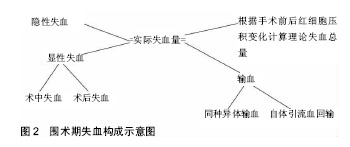| [1] 胥少汀,葛宝丰,徐印坎,等.实用骨科学[M].4版.北京人民军医出版社,2015:947-958.[2] 高化,王宝军,赵亮,等.股骨转子间骨折围手术期的并发症及死亡原因分析[J].中华骨科杂志,2015,35(8):819-824.[3] Marks R, Allegrante JP, Ronald MacKenzie C, et al. Hip fractures among the elderly: causes, consequences and control. Ageing Res Rev. 2003; 2(1):57-93.[4] Nadler SB, Hidalgo JH, Bloch T. Prediction of blood volume in normal human adults. Surgery. 1962;51(2): 224-232. [5] Nelson AR, Brown LB. Hidden hemorrhage: an uncommon complication of a common operation. Ariz Med. 1966;23(12): 919-921.[6] Gross JB. Estimating allowable blood loss: corrected for dilution. Anesthesiology. 1983;58(3):277-280.?[7] Brecher ME, Monk T, Goodnough LT. A standardized method for calculating blood loss. Transfusion. 1997;37(10): 1070-1074. [8] Sehat KR, Evans R, Newman JH. How much blood is really lost in total knee arthroplasty? Correct blood loss management should take hidden Losintoaccount. Knee. 2000;7(3):151-155. [9] Foss NB, Kehlet H. Hidden blood loss after surgery for hip fracture. J Bone Joint Surg Br. 2006;88(8):1053-1059.?[10] Erskine JG, Fraser C, Simpson R, et al. Blood loss with knee joint replacement. J R Coll Surg Edinb. 1981; 26(5): 295-297.[11] McManus KT, Velchik MG, Alavi A, et al. Non-invasive assessment of postoperative bleeding in TKA patient w Tc-99m RNCs. J Nuclear Med. 1987;28: 565-567.[12] Pattison E, Protheroe K, Pringle RM, et al. Reduction in haemoglobin after knee joint surgery. Ann Rheum Dis. 1973;32(6): 582-584.[13] 徐未民,李永刚.全膝关节置换术后隐性失血的研究现状[J].东南大学学报(医学版),2016,35(1):116-120.[14] Yuan T,Cong Y,Meng J,et al. Arachidonic acid causes hidden blood loss-like red blood cell damage through oxidative stress reactions. J Surg Res. 2017;211(1):14-20.[15] Faris PM, Ritter MA, Keating EM, et al. Unwashed filtered shed blood collected after knee and hip arthroplasties. A source of autologous red blood cells. J Bone Joint Surg. 1991; 73(8):1169-1178. [16] 邓硕曾,宋海波,刘进. 循证输血与输血指南[J]. 中国输血杂志, 2006, 19(4): 263-264.[17] 夏克明,朱伟民,杨鹏,等.老年人工全髋关节置换术与全膝关节置换术后隐性失血的相关机制及输血策略[J].中国老年学杂志, 2017,37(8):1954-1956.[18] Cushner FD, Friedman RJ. Blood loss in total knee arthroplasty. Clin Orthop Relat Res. 1991;269(269):98-101. [19] Bell TH, Berta D, Ralley F, et al. Factors affecting perioperative blood loss and transfusion rates in primary total joint arthroplasty: a prospective analysis of 1642 patients. Can J Surg. 2009;52(4): 295-301.?[20] Ju H, Hart RA. Hidden blood loss in anterior lumbar interbody fusion(ALIF)surgery. Orthop Traumatol Surg Res. 2016;102(1): 67-70.[21] 刘国印,贾小宝,张勇,等.老年人营养状况与髋部骨折术前隐性失血的相关性研究[J].中华骨与关节外科杂志,2018,11(1):15-19.[22] Miao K ,Ni S ,Zhou X ,et al. Hidden blood los s and its influential factors after total hip arthroplasty.J Orthop Surg Res. 2015;10(1):1-5.?[23] 王利伟,王洪炳,闫金成,等.闭合股骨干骨折修复术前隐性失血的规律[J].中国组织工程研究,2014,18(53):8623-8628.[24] 卢国平,戴杰,洪晓亮,等.老年高龄髋部骨折患者围手术期隐性失血的相关性研究.中华骨科杂志, 2017, 37(12): 728-734. [25] Bowditch MG, Villar RN. Do obese patients bleed more? A prospective study of blood loss at total hip replacement. Ann R Coll Surg Eng. 1999;81(3):198-200.[26] 邱旭升,陈东阳,徐志宏,等.全膝关节置换术后隐性失血危险因素的分析[J].实用骨科杂志,2012,8(6):510-512. ?[27] 应霁狲,刘观赕,张勇,等.三种不同内固定方式治疗股骨转子间骨折术后隐性失血及血栓形成的比较[J]. 中华创伤骨科杂志, 2016,18(5):442-446.[28] 侯国进,周方,张志山,等.不同内固定方式治疗老年股骨粗隆间骨折围手术期的失血特点分析[J].北京大学学报(医学版),2013, 45(5):738-741.[29] Morritt DG, Morritt AN, Kelley SP, et al. Blood ordering protocol based on proposed surgical implant in fractured neck of femur patients. Ann R Coll Surg Eng. 2005;87(6):445. [30] 林海平,陈健,李清浩.腰硬联合麻醉和全身麻醉在老年患者股骨颈骨折手术的麻醉观察[J].海南医学,2012,23(2):61-62.[31] García-Erce JA, Cuenca J, Martínez F, et al. Perioperative intravenous iron preserves iron stores and may hasten the recovery from post-operative anaemia after knee replacement surgery. Trans Med. 2006;16(5):335-341.[32] 梁鼎天,杨雪平,黄金兰.乳酸亚铁治疗股骨粗隆间骨折隐性失血的疗效分析[J].当代医学,2014,20(1):3-5.[33] Robinson CM, Christie J, Malcolm-Smith N. Nonsteroidal anti-inflammatory drugs, perioperative blood loss, and transfusion requirements in elective hip arthroplasty. J Arthroplasty. 1993;8(6):607-610. [34] 徐海永,张明,方怀玺,等.初次全髋关节置换后的隐性失血:影响因素分析[J]. 中国组织工程研究, 2015, 19(13):1974-1978.[35] Ren Z, Li S, Sheng L, et al. Efficacy and safety of topical use of tranexamic acid in reducing blood loss during primary lumbar spinal surgery: a retrospective case control study. Spine (Phila Pa 1976). 2017;42(23):1779-1784. [36] Soni A, Saini R, Gulati A, et al. Comparison between intravenous and intra-articular regimens of tranexamic acid in reducing blood loss during total knee arthroplasty. J Arthroplasty. 2014;29(8):1525-1527.[37] Goyal N,Chen DB,Harris IA,et al.Intravenous vs intra-articular tranexamic acid in total knee arthroplasty:a randomized double-blind trial.J Arthroplasty. 2017;32(1):28-32.[38] Zhao-Yu C, Yan G, Wei C, et al.Reduced blood loss after intra-articular tranexamic acid injection during total knee arthroplasty: a meta-analysis of the literature. Knee Surg Sports Traumatol Arthrosc. 2014;22(12):3181-3190.[39] Kokoroghiannis C, Aktselis I, et al. Evolving concepts of stability and intramedullary fixation of intertrochanteric fractures -a review. Injury. 2012;43(6) :686-693.[40] 葛鸿庆,黄漫华,陈文治,等.股骨转子间骨折PFNA内固定术后隐性失血及其相关因素分析[J].中国矫形外科杂志, 2015,23(24): 2225-2229.[41] 顾小明,包洪卫,吴灿华,等.老年股骨粗隆间骨折手术隐性失血的危险因素分析[J].中国矫形外科杂志,2015,23(22):2038-2042.[42] 黄家谷,张克,田华,等.单侧初次全膝关节置换后隐性失血的因素分析[J].中国组织工程研究,2016,20(26):3823-3829.[43] 卢国平,戴杰,洪晓亮,等.老年高龄髋部骨折患者围手术期隐性失血的相关性研究[J].中华骨科杂志,2017,37(12):728-734. |
.jpg)


.jpg)
.jpg)